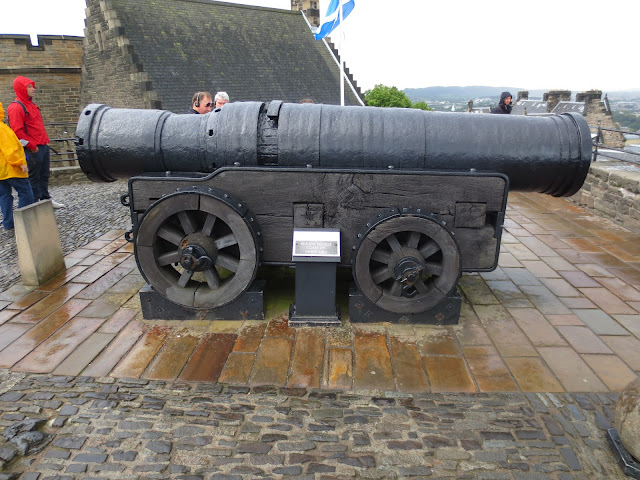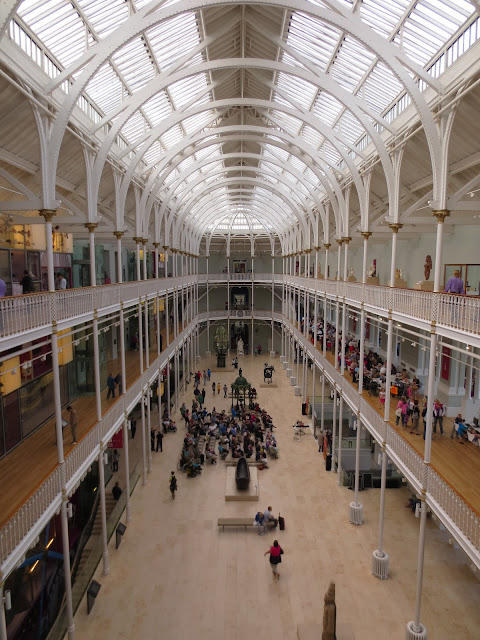22.08.12 - (Edinburgh, Scotland)
The fortress that looks out over Edinburgh, which appears as though whittled from the black stone of Castle Rock, dominates the Celtic skyline. I cannot help but stare as I make my way from
Waverly Bridge, through the park, and along the borders of Old Town. I'm staring at the castle as I go, and the castle, despite its lack of human ocular facilities, its windows like dozens of gossamer eyes seem to watch me too. There are other unique sights as well: the Assembly Rooms, marked by
a giant brown spire, so big that you can navigate the city by looking
for it. Then there's Old Town itself, a flurry of historic
structures, hidden pathways, and winding roads. There are many sights in Edinburgh, but then there is the castle. You have to go to the castle first.
My strategy for seeing the city is to grab
a hop-on-hop-off map and follow the path that the busses take without
actually paying for their services. I might be cheap, but I've found
that it's just as easy to go it on foot in UK cities. You get to know
them much quicker: you find each city's secret places, you tickle the
nape of its neck, mentally mapping out its backbone. The imprint is
like a clear memory, though all it is is walking directons, the
oddball landmark, or a simple feeling. While I will perhaps not be in
Edinburgh long enough to go everywhere (it is a city of 450,000
people, after all), I can do my best.
Following the tour bus route, I arrive
at Edinburgh Castle at ten twenty, just as the clouds darken to
annoint me with their cool Celtic waters. There is too much to say
about Edinburgh Castle, so I'm not sure where to begin. First, I
encounter disappointment. Edinburgh Castle, while beautiful, is not
even remotely similar to the castle that was around in the time of
the Wars of Scottish Independence, or any time during the middle ages. In fact,
what the Castle is, to be clear, is an amalgamation of sixteenth,
seventeenth, eighteenth, and nineteenth century restorative efforts. Some form of either a castle or palace were present here since the ninth century, but there is no current indication as to what kind of structure or what it was used for. There has been a royal castle on Castle Rock since David I. The castle was under constant use but was never taken by an invading army. Going back in time still, the medieval portions
of the castle are now buried deep under the new facade. The Castle is
really nothing like of the structure that was once used on this site
many hundreds of years ago, but as I walk around with my audio guide,
pressing the green to hear more, I realize that that sometimes
restorative efforts are all we can really hope for.
 Still, there are traces of the medieval. Two main sections survive. The first is David's Tower, which collapsed and is now partially housed in Half Moon Battery near the north portion of the castle. Here was once the site of the "Black Supper" (see photo at right) in which, in November 1440, the sixteen year old William, 6th Earl of Douglas, and his brother David were arrested on trumped-up charges of treason and beaheaded on the castle grounds by Sir Edward Crichton, Keeper of Edinburgh Castle, who sought to overthrow the Earls of Douglas.
Still, there are traces of the medieval. Two main sections survive. The first is David's Tower, which collapsed and is now partially housed in Half Moon Battery near the north portion of the castle. Here was once the site of the "Black Supper" (see photo at right) in which, in November 1440, the sixteen year old William, 6th Earl of Douglas, and his brother David were arrested on trumped-up charges of treason and beaheaded on the castle grounds by Sir Edward Crichton, Keeper of Edinburgh Castle, who sought to overthrow the Earls of Douglas.
The second trace of the medieval is St. Margaret's Chapel, which still stands in the upper courtyard (albeit with some restoration as well).
 |
| It starts raining and everyone runs into the smallest building in Edinburgh Castle, which also happens to be the oldest surviving structure (from the 12th century) Margaret's Chapel. |
Besides being a working fortification, Edinburgh Castle is also home to several museums on Scottish military history. I do my best not to glaze over while walking through these exhibits. The interesting bits are with fifteenth century warrior gear: swords, kilts, off-hand dirks. Highlanders would fight with a sword in one hand and a dirk in the other, allowing both slashing and stabbing potentials, and making them fiersome warriors at medium to close range.
 |
| Here's the bombard Mon's Meg. There are differing stories about the origins of Mons Meg, so I'm really not sure what to believe. It was certainly given to King James II of Scotland in the mid-15th century. The castle was used as an artillery and weapons storage during this time. |
 So, it seems there's a whiskey tasting
at Edinburgh Castle (for free!) and I jump at the opportunity to
taste 15 year old single malt scotch.
So, it seems there's a whiskey tasting
at Edinburgh Castle (for free!) and I jump at the opportunity to
taste 15 year old single malt scotch.
My experience went something like this:
12 year? Ohh yummy.
15 year? Oh wow this is REALLY good, what price is... HOLY SHIT IT'S 62 POUNDS, I'M OUT.
 |
| Heeeey, this looks familiar... |
You can literally spend the
whole day at Edinburgh Castle. Unfortunately, I only have a few days
in the city, so I have to move along.
...
My next stop is the National Museum of
Scotland, which is sort of a bust. There's a lot to do there, but
there are so many replicas of actual historical artifacts that I
start to get irritated with the place. The best thing about it is the
buiding itself, boasting a beautiful multi-tiered common room and
exhibit rooms.
I walk around to the East side of Old
Town and out toward Holyrood Park. There, I find Arthur's Seat. It's
sort of a large hill, and it's not that difficult to get up. The
distance is maybe a mile or two, but it's totally worth it. Atop
Arthur's Seat, the wind whistles and blows. From up here, I can see
all of Edinburgh. And not just the city, but the Orkney Islands and
the surrounding towns...

 At the top I run into Rene, who I actually first met in Bath about four or five days ago. The meeting wasn't planned, but it was fortuitous to run into him here. He says that he's been walking since about ten in the morning and he's seen almost the entire city. After talking for a little while, we decide to stick together for the day, find some food and have a few beers and share some of our stories from the days since we'd last seen each other.
At the top I run into Rene, who I actually first met in Bath about four or five days ago. The meeting wasn't planned, but it was fortuitous to run into him here. He says that he's been walking since about ten in the morning and he's seen almost the entire city. After talking for a little while, we decide to stick together for the day, find some food and have a few beers and share some of our stories from the days since we'd last seen each other.
Rene is from Quebec, Canada, and he's traveled more than anyone I've met on this three month trip. He's been to Spain, Germany, Taiwan, Thailand, Cambodia, France, Italy, the UK and all over the United States. He's seen more than you could ask a fairly energetic thirty four year old to see. He's been travelling for more than a year. And it started, he says, with taking a short holiday from work. He didn't really like his job, so he just never went back.
Walking around the city, I run into the stand-up comic, Tom O'Mahoney, from the day before, handing out flyers for his comedy show. He remembers my name and we exchange a pleasant chit-chat before he agrees to a photo op.
 |
| Thanks for the photo and the show, Tom! |
 |
| Fleshmarket Close. |
The rest of the day is spent hanging out with Rene. Rene is a fascinating guy, and he has more stories than I can recount (or recount well). He is, like me, at the tail-end of his travels. And after talking it appears that he's a tad bit homesick (especially as he tries to deny it). I admit that I'm somewhat homesick too, but for my family and friends, not so much for the place.
We decide to walk around and see some of the outdoor Fringe performers, get some drinks, and find a cheap doner kabob place he's been wanting to try. After a while, we split a bottle of wine from a pub for seven quid and then we part ways. I wish him all the best in the rest of his travels.














No comments:
Post a Comment